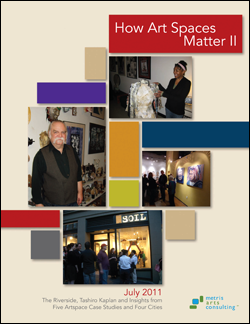How Art Spaces Matter II
The Riverside, Tashiro Kaplan and Insights from Five Artspace Case Studies and Four Cities
2011, 95 pages. Artspace Projects, 250 Third Avenue North Suite 500, Minneapolis, MN 55401, (612) 333-9012, http://www.artspace.org/.
Download:
![]() How Art Spaces Matter II (5.5Mb)
How Art Spaces Matter II (5.5Mb)
This report and its predecessor, How Artist Space Matters (2010), explore how and why art spaces benefit in-house artists, arts organizations, and surrounding neighborhoods and regions. Artspace Projects developed the two case studies detailed in this report, the Riverside Artist Lofts (Reno, NV) and Tashiro Kaplan Artist Lofts and Tashiro Arts Building (Seattle, WA), as well as the three Twin Cities projects explored in our first report. The report provides both an in-depth exploration of how the Riverside and Tashiro Kaplan benefit in-house arts tenants and their neighborhoods and regions. It synthesizes findings from all case studies to glean casual factors that enhance and limit project outcomes. In consultation with Artspace, we selected Reno’s Riverside Artist Lofts, completed in 2000, and Seattle’s Tashiro Kaplan, completed in 2004, to broaden our pool of case studies to include projects outside of the Twin Cities metro and more recently completed projects.
Majorities of Riverside and Tashiro Kaplan artist survey respondents indicated that the buildings work: that is, they are affordable and meet artists’ overall needs. The Riverside and Tashiro Kaplan cases also support proponents’ assumptions that by co-locating artists, the sum of the whole will be larger than that of its parts. Survey and interview data reveal the Riverside and Tashiro Kaplan projects foster artists’ synergies with increases to collaborations, networking, and the sharing of equipment, resources, and skills. Interviews and surveys provided evidence that art spaces can help artists improve their professional reputations and strengthen their identities as artists. Majorities of artist respondents credited the artist space with enhancing their ability to create their art through time and productivity benefits. Some artists translated these enhancements into increased livelihood.

